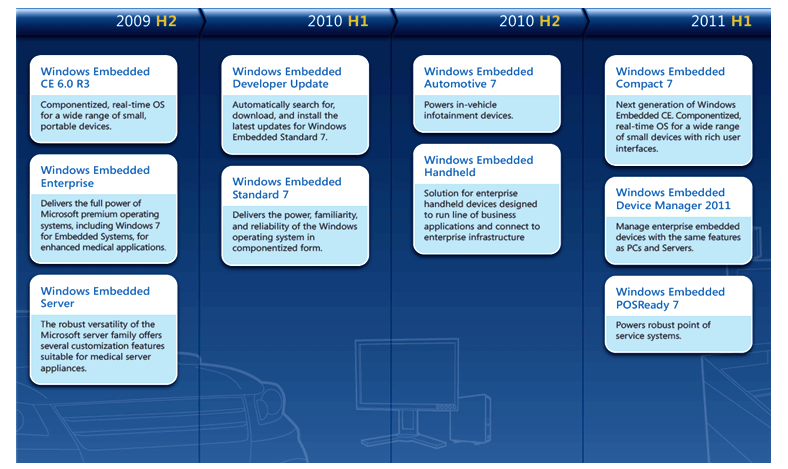Windows Embedded Handheld 7 slips off the Microsoft roadmap

A year ago, Microsoft officials went public with their roadmap for the company's various embedded mobile operating systems. At that time, the Redmondians said to expect Windows Embedded Handheld 7 -- an enterprise-targeted update to its ruggedized-device operating system -- to arrive in the second half of calendar 2011. But those plans seemingly have changed.
Here's the back story: With the Windows Embedded Handheld 7 product, Microsoft planned to move to the Windows Embedded Compact 7 core, and add support for the same development tools that Windows Phone 7 support: Visual Studio 2010, Silverlight and the XNA platform. Embedded Handheld 7 “will support richer experiences and richer applications,” a Microsoft officials said. In addition to supporting a stylus for input, Embedded Handheld 7 also would support multi-touch, according to the company.
The commitment from Microsoft meant that enterprises betting on the current Windows Embedded Handheld product -- built around the end-of-lifed Windows Mobile 6.5 core -- weren't at a dead-end. There would be another version of the ruggedized OS product coming with features more comparable to those Microsoft was providing on the consumer side with the Windows Phone OS.
An eagle-eyed reader of mine who bet on Windows Embedded Handheld 6.5 noted a recent change on Microsoft's updated Embedded Roadmap Web page.
(click on the timeline above to enlarge)
Notice that there's no more mention of Embedded Handheld 7. The timeline cuts off at the end of the first half of 2011. In other words, this tail end of the roadmap is nowhere to be found. Here's that missing piece, which Microsoft provided to me a year ago:
The same reader also noted that a video clip of Kevin Dallas, General Manager of Windows Embedded, tread carefully around the issue as to what will be the successor to Windows Embedded Handheld. Dallas noted that Microsoft would provide mainstream support for Windows Embedded Handheld devices until 2014, and extended (paid) support until 2019. He also said that the team was hard at work on "the next platform that will power the next generation of enterprise handhelds." Dallas never used the words "Windows Embedded Handheld 7."
There are a couple of plausible explanations as to why Microsoft has removed all Windows Embedded Handheld 7 references from its Embedded site. Windows Embedded Compact 7 was delayed by a number of months, and was not made generally available until early March, 2011. That may mean that the Embedded Handheld 7 product -- slated to be built on top of Embedded Compact 7 -- also has slipped and won't actually ship this year. Or Microsoft may have decided that Windows 8, which will run on system-on-a-chip architectures from ARM, Intel and AMD, may become the successor to Windows Embedded Handheld 6.5. Or perhaps Microsoft's "we will share no roadmap before the product is completely coded" philosophy has now taken hold inside the Embedded team....
I've asked Microsoft for comment on what's going on with Windows Embedded Handheld 7 but haven't heard back yet. I will update this post if and when I do.
Update 1: Unsurprisingly, Microsoft isn't talking about whether or not Embedded Handheld 7 is still in the cards. Here's the full reply, via a company spokesperson:
"We remain committed to the enterprise handheld device market, recently illustrated by the release of Windows Embedded Handheld 6.5 – this included extending the support lifecycle for Windows Embedded Handheld to align with the typical five to seven-year lifecycle of business applications in the enterprise, with mainstream support running through December 2014 and extended support runs through December 2019. We are not disclosing any new information concerning our roadmap for the Windows Embedded Handheld platform at this time."
Meanwhile, the Embedded team did ship a new product this week: Windows Embedded Device Manager 2011. That product is designed for the management of Windows-Embedded-based thin clients, point-of-sale systems, digital signage and kiosks. Embedded Device Manager 2011 "extends" the capabilities of System Center Configuration Manager 2007, the Softies said.
I am curious whether the new Embedded Device Manager 2011 product also will be able to manage Windows Embedded Compact 7 devices, Windows Mobile and/or Windows Embedded Handheld devices, as there is no mention of support for any of those operating systems on the Device Manager Web site. I'm also curious if this new Embedded Device Manager release will support the System Center Configuration Manager 2012 product, which is on track to ship this year. (Microsoft delivered a second beta of SCCM 2012 -- which will be able to manage Windows Phone 7, iOS and Android devices, this week.) I've asked Microsoft officials for comment on these details, as well....
Update 2: The aforementioned spokesperson answered some of the questions I had.
Embedded Device Manager 2011 cannot be used with SCCM 2012. The official word: Embedded Device Manager "cannot be used with System Center Configuration Manager 2012 at this time. However, our roadmaps are closely aligned, and moving forward we will coordinate our future product releases to ensure enterprises are able to harness the latest technologies from Microsoft to manage their PCs, servers and embedded devices."
And for now, the only devices that are manageable via Embedded Device Manager 2011 are the ones I mentioned above. "As we look to expand the solution’s capabilities and functionality, we will evaluate opportunities to extend support to other devices built on Windows Embedded’s portfolio of platforms, including enterprise handheld devices built on the Windows Embedded Handheld platform," the spokesperson added.
